
|

|
Forum Index : Solar : Solar hot water and frost.
| Author | Message | ||||
| lamington Newbie Joined: 22/02/2015 Location: AustraliaPosts: 3 |
Hi all I am experimenting with a reptile heater into the bottom of my H/W panels a bit like the 5watt resistor mentioned previously well the reptile heater is a power cord and has a cable attached and you use it to put in a reptile house and what it does is keep the reptiles at a warm temperature in the colder months of the year. On another member had drilled a small hole in the bottom of his h/w panel and inserted a small 5watt resistor and fed it with 12volts and it stopped the panel from freezing up and also stopped ice from building up on the glass. So my idea is to get a reptile heater cord and drill a small hole into the bottom of the h/w panel then feed in the heater cord so it snakes along the bottom of the panel then with a thermostat that I have set the unit with a hysteresis of 4c switch on and 6c switch of and all fed from a control box under my eves. That is my plan for this coming winter. The thermostat I obtained was o/s via ebay with built in relay at around $17.00au it works from -35c to 150c comes with probe and instructions,so I have just got to throw the thing together and pray. I had considered using a 12v hot water solenoid from a scrapped washing machine the one used to fill the machine and connecting it to where the frost valve wold normally be as the solenoid has a 1/2 flange so it screws straight on to the panel at the bottom then drilling a hole straight through the out let one side to the other so when the relay clicked in it would activate the solenoid and purge some of the cold water out of the panel, as the water flows though the solenoid valve the water temp would be monitored by the temp probe at the outlet as the water temp rises the thermostat would disengage the solenoid thereby stopping the flow of water. I fell both systems have merit 1 the heater method if you have P.V.panels won't cost you much in power and also save on water charges. 2 The purge method if you are not worried by minimal water wastage. So I hope you find the above info interesting and any feedback would be appreciated. I will provide a link to a site in Australia http://stores.ebay.com.au/waterlifeaquariumadvantagepets?_tr ksid=p2047675.l2563 |
||||
| lamington Newbie Joined: 22/02/2015 Location: AustraliaPosts: 3 |
Hi Folks Well I did it I installed 2x15 watt reptile heaters in my hot water panels and I am in the process of wiring up a thermostat for them. The reptile cord heaters cost me around $40 including postage from Sydney and are of the waterproof type and run on 240v and have a controlled temperature so not to burn themselves out. Plus the thermostat cost me a princely sum of $15 from guess where (e-bay) Anyway I have enclosed some pics of the installation, if you are interested please leave some comments as I would gladly receive accolades and constructive criticisms. A few pics out of sequence my apologies so enjoy Lamington Pavlova (a sweet guy) |
||||
MacGyver Guru Joined: 12/05/2009 Location: United StatesPosts: 1329 |
Gizmo I may have addressed this in another thread or in this one earlier on; I don't remember. Anyway, I use solar here in Texas and found a great way to get around the freezing issue. I built a collection array with a bottom and top header pipe and vertical pipes connecting each in between. I don't have a picture, but imagine the letter "H" with several cross bars and lying on its side. It looks like that anyway. I used "PEX" pipe, which is some sort of polybutylene, I think. Anyway, it can freeze solid and it doesn't hurt a thing. It stretches and does not split or burst. I still drain it during the winter (I'm a retired plumber and just can't live with myself knowing I left water in an exposed pipe in near-zero outside temps.) but I don't really have to and just in case I'm away when a freeze hits, no worries. Remember Alfred E. Newman from Mad Magazine? His life's verse was, "What?" "Me worry?" That's how I view my PEX solar collector these days. Hope this helps. Oh, turns out, the connector fittings (tees) are brass, but they are only half inch, which is in this case measured on their outside. Their volume is very small. There's enough room within the body of the PEX pipe to allow the water to expand before it bursts the fittings. . . . . . Mac Nothing difficult is ever easy! Perhaps better stated in the words of Morgan Freeman, "Where there is no struggle, there is no progress!" Copeville, Texas |
||||
| flc1 Senior Member Joined: 20/11/2011 Location: New ZealandPosts: 242 |
gday, I have a 300 litre solar water heater with 30 glass vacum tubes, they don't freeze because of the vacum between the two layers of glass, so if you could have a vacum in your panels,problem solved, or if you can afford it, sell your system and go for glass vacum tube system, |
||||
| davef Guru Joined: 14/05/2006 Location: New ZealandPosts: 499 |
I have a similar setup and the warranty from SolarCity will be void if water doesn't periodically circulate through the panel when the temperature drops below 4-5C. You need a closed system with "antifreeze" in it and getting council approval for that seemed too difficult. |
||||
| flc1 Senior Member Joined: 20/11/2011 Location: New ZealandPosts: 242 |
the glass tubes don't need antifreeze in them, they either have the water, and work by thermosyhin,or have copper tubes filled with a heat transfer liquid,and the copper tubes fits inside the glass tubes,the tip of the copper tube protrudes inside the water tank and heats the water,both of these systems will not freeze. |
||||
| lamington Newbie Joined: 22/02/2015 Location: AustraliaPosts: 3 |
Hi guys Another solar hot water hack. As I had installed reptile heaters in the bottom of my panels earlier post.Anyway as we have had some heavy frosts -5 c and the reptile heaters are doing great but I had noticed a small amount of frost in top of the panels so what to do pullout the old heaters and install higher wattage ones.Hmm As my wife was packing up some picture frames to store in the shed I had noticed that there was some bubble wrap left over so me being inventive I carried out an experiment to see if the bubble wrap would act as an insulating barrier if installed on the face of the panels. So up on the roof I go (my second home you know I will come back as a possum!)Then fitted 2 sheets of bubble wrap smooth side up and WOW did it work well not only did it keep off the frost on the glass but also still collected hot water in the daytime I think it acts as double insulation. So what if I need to replace the bubble wrap every winter for $5.00 a lot cheaper than frost valves. Now in saying that I have been thinking of installing a couple of sheets of polycarb roofing from Bunnings and sealing the edges with double sided adhesive foam so the panels are doubled glazed. To the fella that has the evacuated tube system ,the tubes a filled with glycol mix and are manufactured in china so beware that it never get in your home water supply it is a very toxic product and I personally would not be any where near the stuff and I would not have the stuff in my car radiator if I my way. |
||||
Madness Guru Joined: 08/10/2011 Location: AustraliaPosts: 2498 |
Propylene Glycol is a common ingredient in moisturiser, not saying it is good for you but you are not going to drop dead putting it in your radiator. There are only 10 types of people in the world: those who understand binary, and those who don't. |
||||
| Gizmo Admin Group Joined: 05/06/2004 Location: AustraliaPosts: 5078 |
Dont drink it though. Apparently its tastes ok, a dog will drink it, and then need to be rushed off to the vet real fast. Glenn The best time to plant a tree was twenty years ago, the second best time is right now. JAQ |
||||
| flc1 Senior Member Joined: 20/11/2011 Location: New ZealandPosts: 242 |
Gday Lamington, from what I have seen of the evacuated tube type water heaters,there seems to be one or two types with the glycol or whatever the chemical is called, in the copper tubes, and connected to the manifold,which the water is pumped through- heat transferr,and other types with copper coils inside tanks,for heat transferr , another type that has seperate copper tubes in each evacuated glass tube with what I have been told is just water inside the copper tubes, which boils and rises to the top of the copper tube,which is inserted in the water tank. The type which has only the water inside the glass evacuated tube is the type I have had best results with, very simple, maintinace free ,no copper tubes and does not freeze untill the temperature drops to about -20c or something around there,doesn't get that cold here where we are, |
||||
| flc1 Senior Member Joined: 20/11/2011 Location: New ZealandPosts: 242 |
solar vacum tubes in a -4c frost 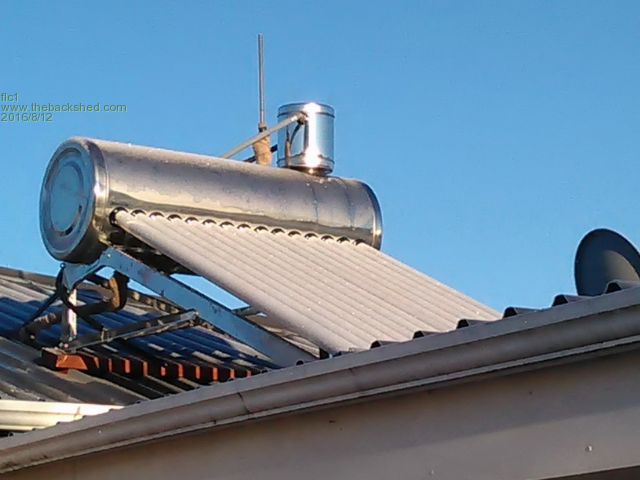
|
||||
| flc1 Senior Member Joined: 20/11/2011 Location: New ZealandPosts: 242 |
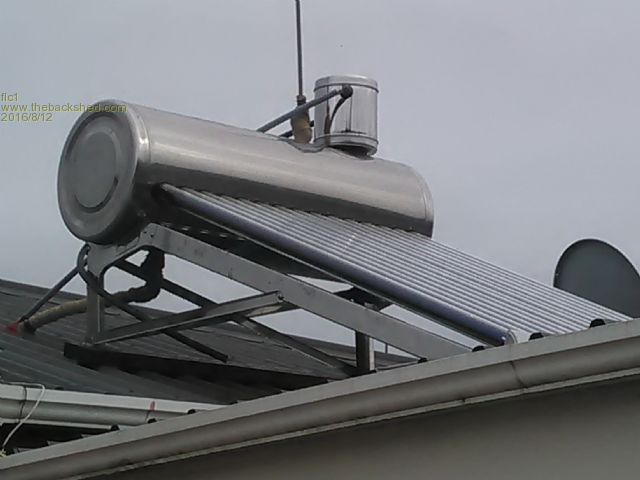
just glass n stainless steele, no copper tubes,, simple but works well |
||||
| flc1 Senior Member Joined: 20/11/2011 Location: New ZealandPosts: 242 |
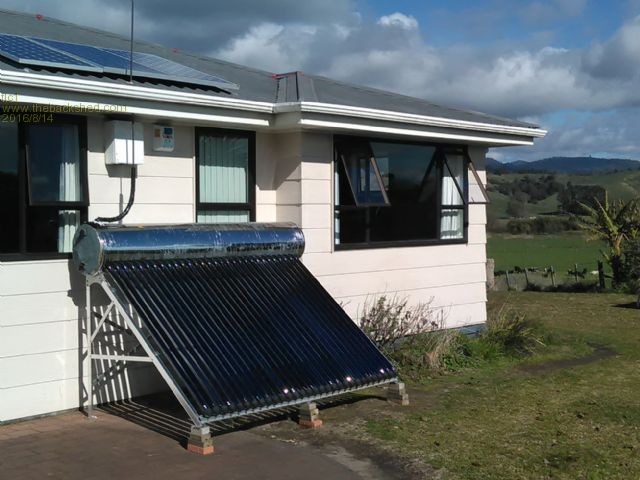
Our 300ltr solar water heater with a copper tube in each glass vacum tube. Too heavy to put up on our roof, would have to strengthen the roof. prev photo shows 150 ltr with frost on tubes on our roof,half the weight, |
||||
| flc1 Senior Member Joined: 20/11/2011 Location: New ZealandPosts: 242 |
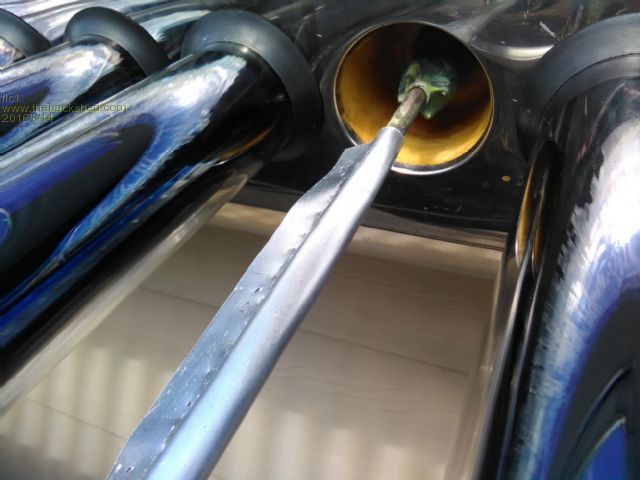
photo showing copper tube insert into water tank, you can see the 2 inch thick insulation between inner water tank and outer tank, the 150ltr solar water heater on our roof has no copper tubes in vacum tubes,water is in the vacum tubes and heats buy thermosyphin, and from what I have seen with our systems here at home, the type with only water in the vacum tubes seems to be the most efficiant of the glass tube type. |
||||
| flc1 Senior Member Joined: 20/11/2011 Location: New ZealandPosts: 242 |
. |
||||
| flc1 Senior Member Joined: 20/11/2011 Location: New ZealandPosts: 242 |
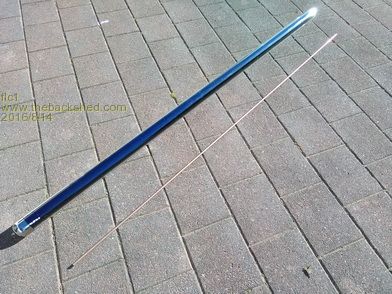
In my opinion, the copper heating tube is just another part that can fail, But with just the water in the glass tubes ,it can't fail unless you break a tube, and that rarely happens and they are cheap and easy to replace. |
||||
| DaveP68 Senior Member Joined: 25/11/2014 Location: New ZealandPosts: 292 |
Hey Fred just got to see your reply to a post on windmills and came across this. You seem to really know your stuff on this, PV solar and F&P Wind turbines. Keep up the good work, as I may have to pick your brains one day when I escape the city heading to a country lifestyle block and kiss good by to the grid connection... Cheers David There are realities if you do not accept, will lead to frustration because you will be spending time on wrong assumptions and the results cannot follow! The Dunning Kruger Effect :) |
||||
| flc1 Senior Member Joined: 20/11/2011 Location: New ZealandPosts: 242 |
Gday Dave,thanks for the compliment,,you know more about f n p stators than I do |
||||
| flc1 Senior Member Joined: 20/11/2011 Location: New ZealandPosts: 242 |
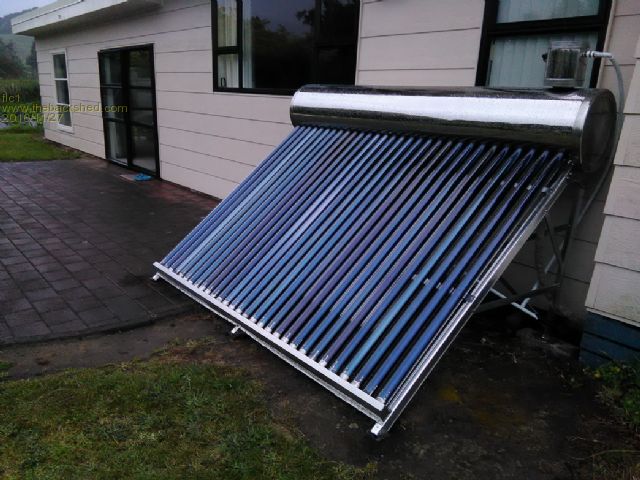 new solar water heater, glass tubes are filled with water, which heats water in tank and there is a copper coil inside tank which has the water for shower,bath etc flowing through it, cold water in one end and hot coming out the other , heat transferr to coil from hot water in tank. this one is alot more efficent than the other one that had the copper rods in the glass tubes. |
||||
| Warpspeed Guru Joined: 09/08/2007 Location: AustraliaPosts: 4406 |
I am pretty familiar with those frost protection valves, but it was a long time ago. Draining off water sounds very dramatic, like Niagara Falls, or Little Johnny. But those valves just dribble and drip a bit, and not much water actually comes out. What happens is a needle valve opens at only a couple of degrees above freezing, and the needle valve holds that slight positive temperature at the drain valve body. So if its only -5C or something for a few hours just before dawn, you might lose only a very few liters of water all night. The water volume and total heat loss is absolutely insignificant. It would make an excellent backup system for any other frost protection system you have. This is all so very important. I would not be confident that a single frost protection system is adequate, unless you test it frequently, which would be very difficult and inconvenient to do. Most people just fit some frost protective device that is never tested again after initial installation. It might go on working for thirty days, or thirty years, who knows ? You will never know it has failed to operate until one day its too late. Cheers, Tony. |
||||